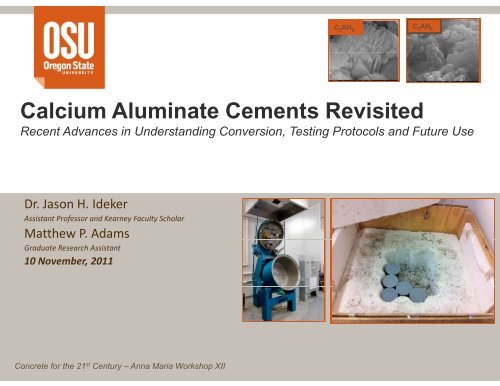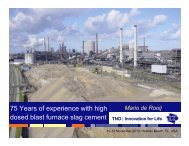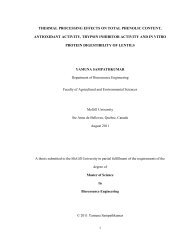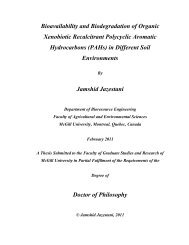Calcium Aluminate Cements Revisited - McGill University
Calcium Aluminate Cements Revisited - McGill University
Calcium Aluminate Cements Revisited - McGill University
Create successful ePaper yourself
Turn your PDF publications into a flip-book with our unique Google optimized e-Paper software.
<strong>Calcium</strong> <strong>Aluminate</strong> <strong>Cements</strong> <strong>Revisited</strong><br />
Recent Advances in Understanding Conversion, Testing Protocols and Future Use<br />
Dr. Jason H. Ideker<br />
Assistant Professor and Kearney Faculty Scholar<br />
Matthew P. Adams<br />
Graduate Research Assistant<br />
10 November, 2011<br />
Concrete for the 21 st Century – Anna Maria Workshop XII<br />
C2AH 8<br />
C 3AH 6
Introduction<br />
Compared to ordinary portland cement (OPC) concrete, calcium aluminate<br />
cement (CAC) concrete is a considerably understudied material<br />
• Early‐age volume change<br />
• Durability<br />
• Conversion<br />
CAC Scientific Network – established by Kerneos <strong>Aluminate</strong> Technologies<br />
(formerly Lafarge <strong>Aluminate</strong>s) in 2004<br />
• The <strong>University</strong> of Texas at Austin (2004)<br />
Early‐age behavior, volume change, durability<br />
• EEcole l Polytechnique P l h i Federale Fd l de d Lausanne L (2006)<br />
Microstructural development<br />
• <strong>University</strong> of New Brunswick (2007)<br />
Durability (corrosion, salt scaling, freeze/thaw, alkali‐silica reaction)<br />
• <strong>University</strong> of Laval (2005‐2011)<br />
Testing strategies, rheology<br />
• Oregon State <strong>University</strong> (2008)<br />
Early‐age volume change, conversion testing
History<br />
1900s –sulfate attack of portland cement concrete in South of France<br />
1908 – Patent for calcium aluminate cement granted to Jules Bied<br />
WWI –used for gun emplacements<br />
1945‐1973 –Post WWII reconstruction, rapid hardening properties<br />
1973‐1974 9 3 9 ‐ Failures il force f removal l of f CCAC Cffrom UK bbuilding ildi regulations l i<br />
1997 ‐ Concrete Society Report<br />
Present<br />
• continued use in building chemistry and refractory applications<br />
Renewed interest as a<br />
• rapid p repair p material<br />
• alternative binder with lower CO2 footprint<br />
• durability
CAC Hydration and Chemistry<br />
CConversion i<br />
Juenger, M.C.G., Winnefeld, F., Provis, J.L. and Ideker, J.H., “Advances in Alternative<br />
Cementitious Binders,” Cement and Concrete Research, V 41 [12], December 2011, pp.<br />
1232‐1243.<br />
Figure - Courtesy of K. Scrivener
SEM Images of CAC Microconcrete (BSE)<br />
T<br />
20 C<br />
20 C isothermal cure, 1 day,<br />
unconverted<br />
t<br />
Scale Bar – 300 �m �m<br />
High strength, low degree of hydration,<br />
low porosity<br />
T<br />
38 C<br />
38 C isothermal cure, 8<br />
days old, fully converted<br />
Lower strength strength, high<br />
degree of hydration,<br />
higher porosity<br />
t<br />
Scale Bar – 300 �m
SEM Images of CAC Paste (BSE)<br />
70 C isothermal cure, T off + 8 hrs<br />
High degree of hydration hydration, high<br />
70 C realistic ramping, T off + 8<br />
hrs<br />
degree of porosity Discrete porosity, metastable<br />
phase development may limit<br />
porosity<br />
SEM Images: C. Gosselin
Rigid Cracking Frame and Free Deformation Frame Results<br />
20 C CAC, OPC<br />
6<br />
November 21, 2011<br />
Total Strain (�mm/m)<br />
1200<br />
800<br />
400<br />
0<br />
-400<br />
slight expansion<br />
GCX 58 micro-concrete<br />
0.6% Accel., 0.3% Super<br />
20 °C Isothermal<br />
OPC 3 micro-concrete<br />
No Admixtures<br />
20 °C Isothermal<br />
artificial cooling<br />
-800<br />
GCX 38 micro-concrete<br />
0.6% Accel., 0.3% Super<br />
20 °C Isothermal<br />
-1200<br />
0 25 50 75 100 125 150 175<br />
Time from Initial Setting (Hours)
Rigid Cracking Frame and Free Deformation Frame Results<br />
38 C CAC andOPC<br />
7<br />
November 21, 2011<br />
Total Strain (�m/ /m)<br />
1200<br />
800<br />
400<br />
0<br />
-400<br />
-800<br />
GCX 29 micro-concrete<br />
0.2% Accel., 0.4% Super<br />
38 °C Isothermal<br />
OPC 4 micro-concrete<br />
No admixtures<br />
38 °C Isothermal<br />
GCX 51 micro-concrete<br />
0.6% Accel., 0.3% Super<br />
38 °C Isothermal<br />
artificial cooling<br />
-1200<br />
0 25 50 75 100 125 150 175<br />
Time from Initial Setting (Hours)
Interim Summary –Early Age Properties<br />
Rigid Cracking<br />
Frame Stress<br />
8<br />
November 21, 2011<br />
Highly temperature dependent<br />
Immediate high<br />
temperature<br />
curing to promote<br />
stable phase<br />
formation in pure<br />
CAC<br />
CAC –early‐age volume behavior<br />
vastly different than OPC<br />
Some benefits (expansion)<br />
Some challenges (shrinkage)
CAC Research and Testing at OSU<br />
• Working with CACs since 2008 (Ciment Fondu, GCX, CAC+SCMs)<br />
• Early‐age volume change: chemical shrinkage, autogenous deformation<br />
• Strength of mortar cubes<br />
• Minor durability testing –ASR related<br />
• Development of a standardized lab procedure for predicting conversion<br />
• Conversion testing since August 2011 – Ciment Fondu<br />
• 24 hr cure in ambient, 24 hr cure in highly insulated box<br />
• 50C submersion at 24 hr for all cylinders y – monitor strength g<br />
• 38C submersion at 24 hr for all cylinders – monitor strength<br />
• 38C direct submersion –QC check
CAC –Curing Regimes<br />
Ambient<br />
• Mixtures of metastable and stable<br />
hydrates<br />
• Curing concrete cylinders roughly<br />
around 23 �C<br />
• May y be typical yp of smaller elements<br />
in the field<br />
Self‐heating<br />
• Direct formation of stable hydrates<br />
• Temperatures seen in larger<br />
elements and/or hot‐weather<br />
concreting<br />
Isothermal (38 �C) C)<br />
• Increased conversion rate from<br />
metastable to stable hydrates<br />
• Lab evaluation protocol for high and<br />
low strength determination<br />
What is conservative? What is<br />
realistic? li i ? How H do d we best b simulate?<br />
i l ?<br />
Semi-Adiabatic Curing Box
Montogmery Data<br />
11<br />
November 21, 2011
Accelerated Conversion Testing ‐ CAC<br />
Equipment Used<br />
Eirich Concrete Mixer and Control<br />
Temperature and Humidity<br />
Panel Controlled Mixing Room<br />
Insulated Curing Box<br />
Temperature Controlled Curing Bath<br />
Cylinder End Grinder and Compression<br />
Temperature<br />
Testing Machine<br />
Data Logger
Accelerated Conversion Testing ‐ CAC<br />
Inexpensive i Laboratory b Water Baths h HHeavily il Insulated I l dC Curing i Box B<br />
•Passive heating coils<br />
•Must be monitored regularly g y<br />
•Temperature easily affected by ambient<br />
temperature<br />
Tank<br />
hheaters t<br />
Temperatur<br />
e monitor<br />
•12” of dense styrofoam surround 16 –<br />
100x200 mm cylinders<br />
•Placed l dimmediately d l after f casting<br />
•Cured for 24 hours<br />
Submersible pump and<br />
temperature recorders (not<br />
shown) Insulated Curing Box
Accelerated Conversion Testing –<br />
Preliminary Results<br />
Cylinders (100 mm x 200 mm) : 24 Hours of Ambient Curing or 24 Hours of<br />
Insulated Box Curing followed by submersion at 50 C<br />
CAC - Ciment Fondu Mixture Design: Mix 1<br />
Cement: 400 (kg/m3 )<br />
Water: 160 (kg/m3 Water: 160 (kg/m )<br />
w/cm: 0.4<br />
Stone: 950 (kg/m3 )(MC - 1.4%, AC - 2.6%)<br />
Sand: 740 (kg/m3 ) (MC - 3.6%, AC - 3.1%)<br />
Super: Opt 203, 1% by mass cement<br />
f'c (MPa)<br />
40<br />
35<br />
30<br />
25<br />
20<br />
15<br />
10<br />
5<br />
0<br />
Compressive Strength (f'c) Evolution Fondu Concrete Mixture 1<br />
Cure for 24 hr in insulated box and<br />
then cure in 50°C water bath<br />
Cure for 24 hr at ambient temp and<br />
then cure in 50°C water bath<br />
0 1 2 3 4<br />
Time (Days)<br />
5 6 7 8
Accelerated Conversion Testing –<br />
Preliminary Results<br />
Mixture 3: Compressive strength: 100 x 200 mm cylinders<br />
Submerged in 38°C Water Bath Directly After Casting<br />
CAC - Ciment Fondu Mixture Design:<br />
Mixture 3<br />
Cement: 400 (kg/m3 )<br />
Water: 160 (kg/m3 )<br />
w/cm: 0.4<br />
Stone: 900 (kg/m3 )(MC - 2.4%, AC - 2.6%)<br />
Sand: 645 (kg/m3 ) (MC - 3.8%, AC - 3.1%)<br />
Super: Opt 203, 1% by mass cement<br />
f'c (MPa)<br />
40<br />
35<br />
30<br />
25<br />
20<br />
15<br />
10<br />
5<br />
0<br />
Compressive Strength (f'c) Evolution Fondu Concrete Mixture 3<br />
Cure for 7 days in 38°C water bath<br />
0 1 2 3 4<br />
Time (Days)<br />
5 6 7 8
Interim Summary –Conversion Testing<br />
Overall both 50C and 38C submersion provide rapid conversion of<br />
cylinders cured in ambient temperatures<br />
After ambient cure<br />
38C –conversion at about 6 days<br />
50C –conversion at about 2 days<br />
Values converge to uniform value for converted strength in both tests<br />
Immediate submersion at 38C confirms roughly 100 hours to conversion<br />
Highest temperature in insulated box ‐ ~90C<br />
Highest temperature in ambient cured cylinders ‐ ~50C
Conclusions and Future Work<br />
Early‐age volume change<br />
• Vastly different behavior than portland<br />
cement<br />
• Highly temperature dependent<br />
Conversion Testing<br />
• Immediate high temperature curing not<br />
applicable due to microstructural changes<br />
• Curing at 38 C immediately gives good<br />
predictor of converted test, not field<br />
compatible<br />
• Ambient curing for 24 hours followed by<br />
submersion at high temp give also good<br />
predictions di i of f converted d strengthh<br />
• 38 C (6 days to conversion)<br />
• 50 C (2 days to conversion)<br />
Early‐age volume change<br />
• Continued characterization of autogenous<br />
deformation, chemical and drying<br />
shrinkage, thermal influences<br />
• Realistic time/temperature histories<br />
• Making the link between laboratory and<br />
field (Bentivegna Dissertation UT Austin)<br />
Conversion Testing<br />
• Varying material parameters (w/cm,<br />
cement content, aggregate type)<br />
• pure CAC systems to start<br />
• more complex systems after initial test<br />
developed, verified<br />
• Propose as new ASTM Standard
Thank you!<br />
http://web.engr.oregonstate.edu/~idekerj/<br />
http://gbml.oregonstate.edu/<br />
18<br />
November 21, 2011<br />
Questions?









